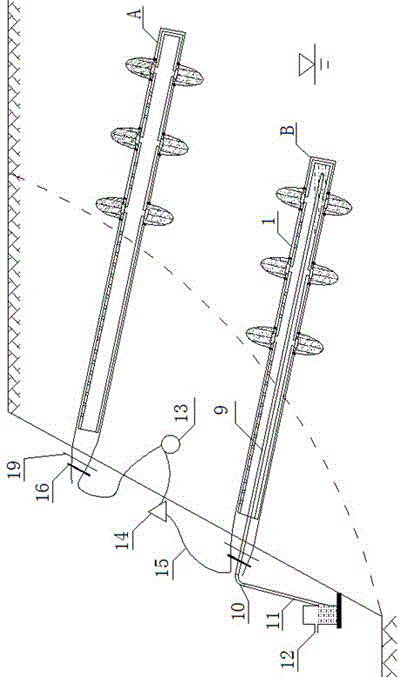Side slope self-drainage electroosmosis anchor rod and construction method thereof
A technology of drainage and anchor rods, which is applied in the direction of foundation structure engineering, soil protection, sheet pile walls, etc., can solve problems such as inability to anchor, and achieve the effects of improving soil strength, good tensile capacity, and preventing seepage holes from clogging
- Summary
- Abstract
- Description
- Claims
- Application Information
AI Technical Summary
Problems solved by technology
Method used
Image
Examples
Embodiment Construction
[0019]The features of the present invention will be further described below in conjunction with the accompanying drawings and specific examples, and the given examples are only used to explain the present invention, and are not intended to limit the scope of the present invention. After reading the present invention, within the spirit and principle of the present invention, any modification, equivalent replacement and improvement should be included in the protection scope of the present invention.
[0020] The working principle of the present invention is: when the moisture content in the slope body is lower than the limit moisture content of the moisture sensor control switch, the moisture sensor control switch is automatically disconnected, the electroosmosis process is not carried out, and the slurry solidified in the bag will not The stable soil is anchored in the stable area; when the moisture content in the slope rises to the limit moisture content of the moisture sensor ...
PUM
 Login to View More
Login to View More Abstract
Description
Claims
Application Information
 Login to View More
Login to View More - R&D
- Intellectual Property
- Life Sciences
- Materials
- Tech Scout
- Unparalleled Data Quality
- Higher Quality Content
- 60% Fewer Hallucinations
Browse by: Latest US Patents, China's latest patents, Technical Efficacy Thesaurus, Application Domain, Technology Topic, Popular Technical Reports.
© 2025 PatSnap. All rights reserved.Legal|Privacy policy|Modern Slavery Act Transparency Statement|Sitemap|About US| Contact US: help@patsnap.com



